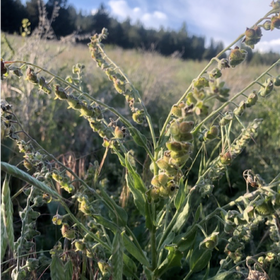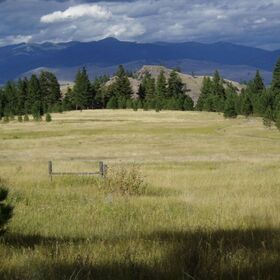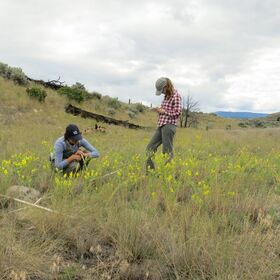Biological invasions (mostly plants)
While thousands of species have been introduced to new continents, only a subset are particularly problematic in their new ranges, often resulting in large negative effects on novel ecosystems. Why some species are spectacularly successful in their new range is a question that has remained difficult to answer.
In collaboration with Metro Vancouver, the Invasive Species Council of BC, David Clements (Trinity Western University), and the B.C. Ministry of Forests, Lands, Natural Resources Operations and Rural Development, we are investigating how risk of invasive plant species in the region around Vancouver (lower mainland) will change with climate change. Led Emma Nikkel (M.Sc. 2022) we want to predict which invasive plants will become more problematic in a warming world using a combination of species distribution models and risk assessments. [photo]
In earlier work, we addressed multiple hypotheses encompassing both ecological and evolutionary mechanisms for exotic plant success, with studies of houndstongue (Cynoglossum officinale), a problematic weed in the Intermountain West. Houndstongue is one of a rare few weeds that have shifted its life history from one of flowering only once in the native range (semelparity) to flowering two or three times in the introduced range (iteroparity). Sophie Duncan (M.Sc., 2019) tested whether the recent colonization of a specialist biological control weevil would lead to a return to semelparity in the northern U.S. (here: paper).
You can read about earlier work on houndstongue here, here & here, and more recent work in British Columbia investigating how the interaction between the invasive Dalmatian toadflax and its specialist root-boring insect changes across B.C. here.
In collaboration with Metro Vancouver, the Invasive Species Council of BC, David Clements (Trinity Western University), and the B.C. Ministry of Forests, Lands, Natural Resources Operations and Rural Development, we are investigating how risk of invasive plant species in the region around Vancouver (lower mainland) will change with climate change. Led Emma Nikkel (M.Sc. 2022) we want to predict which invasive plants will become more problematic in a warming world using a combination of species distribution models and risk assessments. [photo]
In earlier work, we addressed multiple hypotheses encompassing both ecological and evolutionary mechanisms for exotic plant success, with studies of houndstongue (Cynoglossum officinale), a problematic weed in the Intermountain West. Houndstongue is one of a rare few weeds that have shifted its life history from one of flowering only once in the native range (semelparity) to flowering two or three times in the introduced range (iteroparity). Sophie Duncan (M.Sc., 2019) tested whether the recent colonization of a specialist biological control weevil would lead to a return to semelparity in the northern U.S. (here: paper).
You can read about earlier work on houndstongue here, here & here, and more recent work in British Columbia investigating how the interaction between the invasive Dalmatian toadflax and its specialist root-boring insect changes across B.C. here.



